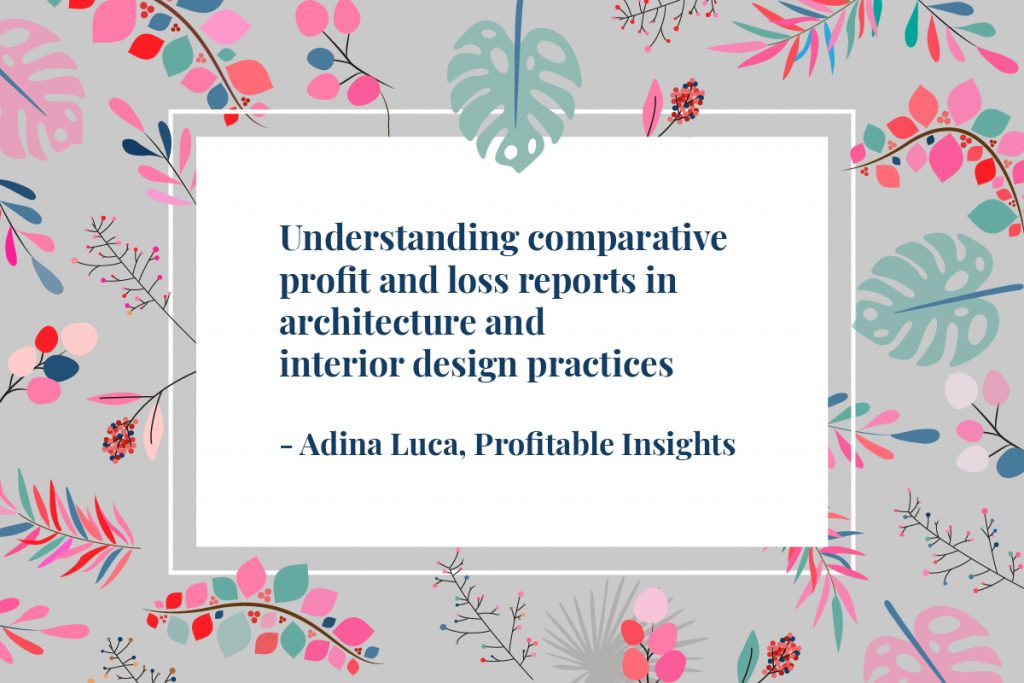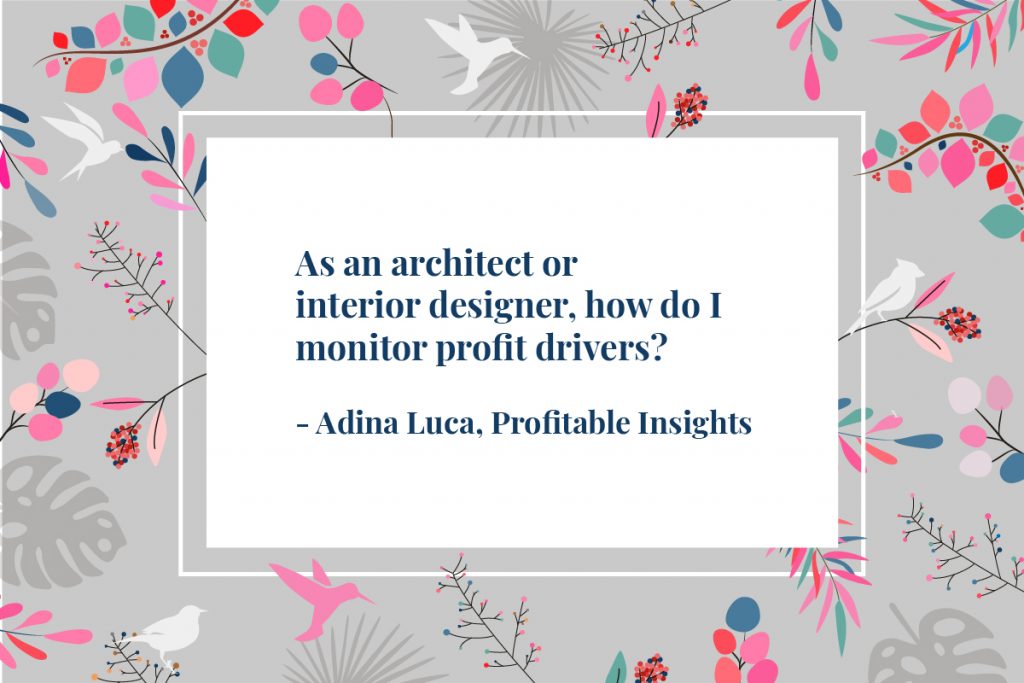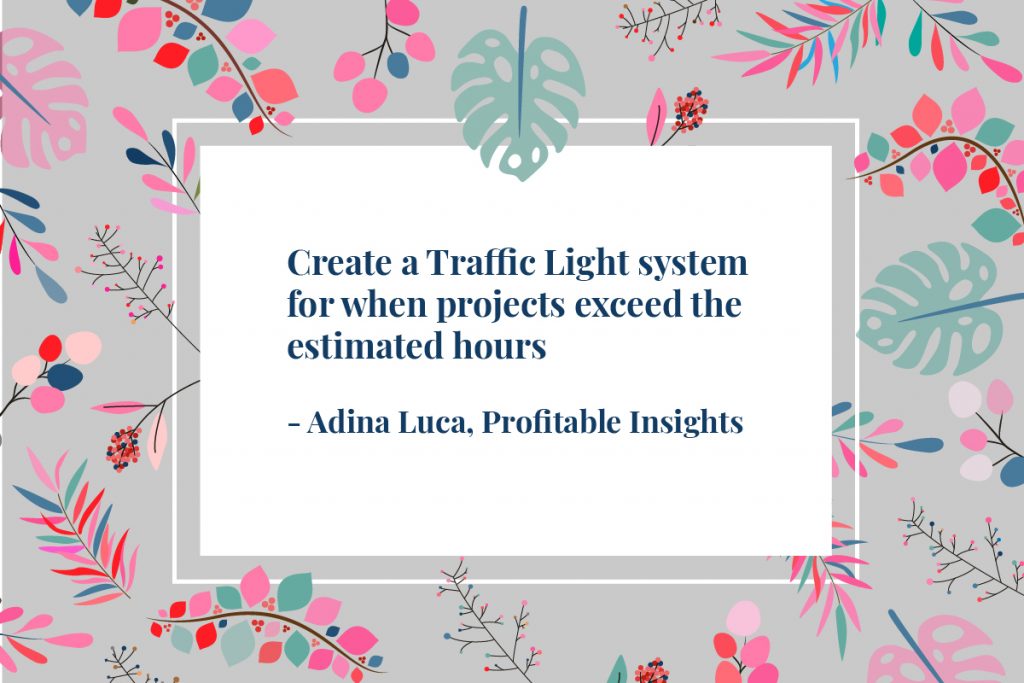Cost management essentials–project profit margin
What is complicated, requires a lot of data analysis, and damages your entire business if not done properly? It is monitoring profit margin of projects for businesses in architecture and interior design. As projects shed labour hours that are difficult to estimate accurately, the labour cost increases and profit margin disappears. Hence, it becomes imperative to control profit margin per project as it will determine your overall profitability.

Understanding comparative profit and loss reports, cost benchmarks and profit-drivers
Architecture, interior design and refurbishment companies are either product-heavy or service-heavy. In other words, they can either emphasise and promote selling of a line of products (for example partitions, electricals, furniture and textiles) where the labour is incidental to the product such as in installation and maintenance. Or they emphasise and promote service excellency (project management, consulting or design expertise) and the product is determined by the design and incidental to the service. The profit and loss structure of the business differs depending on whether they are more material or labour intensive, and whether they rely on outsourced or full-time labour.
Expected profitability and hence pricing calculations will differ along the continuum of product or service orientation. The higher the value added (an emphasis on service quality), the higher the expected profitability per hour of labour.
We built an artificial example to compare the profit and loss pattern against benchmarks for product vs service orientated businesses. As you can see in the table below, both businesses have similar level of revenue and indirect cost, but the direct costs are completely different.Third column for both examples is the industry benchmark to aim for in percentage out of the revenue.
A refurbishment company, reselling products with some installation and design, could aim for a15% operational profit as a reasonable benchmark. Operational profit is also known as“Earnings Before Interest, Taxes, Depreciation, and Amortisation” abbreviated to EBITDA. Are furbishment company will have a lower EBITDA compared to an architecture and interior design company because direct costs form a higher percentage if they sell a line of products alongside the project management and design. However, we should expect a higher volume of sales as products have a shorter sales cycle than expertise.
Refurbishment Company (75% products / 25% services)
| P&L | Actuals | % | Benchmark | |
| Sales | Revenue from trade | £400,000 | 100% | 100% |
| Direct Cost (Variable) | Materials and staff outsourced | -£240,000 | -60% | -60% |
| Net Sales (Contribution) | Revenue minus variable Direct Cost | £160,000 | 40% | 40% |
| Direct Cost (Fixed) | Project management (staff employed) | -£40,000 | -10% | -10% |
| GROSS MARGIN | Net sales minus fixed Direct Cost | £120,000 | 30% | 30% |
| INDIRECT COST | Sales & Mktg, Office, Mgmt | -£100,000 | -25% | -15% |
| EBITDA (operational profit) | Gross Margin minus Indirect Cost | £20,000 | 5% | 15% |
Architecture & Interior Design Company (100% services)
| P&L | Actuals | % | Benchmark | |
| Sales | Revenue from trade | £400,000 | 100% | 100% |
| Direct Cost (Variable) | Materials and staff outsourced | -£40,000 | -10% | -8% |
| Net Sales (Contribution) | Revenue minus variable Direct Cost | £360,000 | 90% | 92% |
| Direct Cost (Fixed) | Project management (staff employed) | -£240,000 | -60% | -32% |
| GROSS MARGIN | Net sales minus fixed Direct Cost | £120,000 | 30% | 60% |
| INDIRECT COST | Sales & Mktg, Office, Mgmt | -£100,000 | -25% | -30% |
| EBITDA (operational profit) | Gross Margin minus Indirect Cost | £20,000 | 5% | 30% |
An architecture and interior design business–which sells mainly design expertise–will have a profitability pattern which follows the rule of three: one third of cost is direct cost, one third of cost is overheads, and one third should be operational profit. EBITDA should settle around 33% for this type of business if pricing is right and project profitability monitoring is done constantly.
The profit margin per project will reflect the unique selling point of each business and willdetermine how pricing and breakeven points are calculated. Monitoring projects will also helpwith identifying and monitoring profit drivers for your business.
Profit-drivers?
Profit-drivers are specific indicators that come out of operational and financial data and their trend indicates whether your business is going in the right direction. In retail, the inventory turnover – how fast the products sell and the level of inventory available / needed, along with their cash implication – can make or break the business. Construction companies need to monitor materials and waste per project to run a profitable business. When it comes to services, time to completion determines the outcome and drives the cost.
Every industry has specific profit drivers that determine efficiency of delivery and impact how much is available for overhead budgeting. Architecture and interior design companies join the other creative industries with the main driver the ability to control the hours spent on design while ensuring the quality of outcome. Easily said than done because there are a million reasons why design projects do not turn out as planned. You cannot rush the creative spark and reality does not bend to ideas.
It is especially difficult to monitor labour hours in a creative industry, where quality and precision of output is more important than time spent.
What are profit drivers for architecture and interior design companies?
It really depends on what the business is specialized on. However, the most important one is the ratio of hours sold vs hours worked. In other words, divide the hours worked by the hours sold per project. This ratio should be closer to 1 and whether it’s trending towards 1 or higher across projects and over time will determine the overall profitability of the business.

As an architect or interior designer, how do I monitor profit drivers?
Project profitability demands a different approach in data collection from the usual financial data that a company has. You need a project-by-project data collection template, usually by assigning job codes, and the discipline to follow through whenever you collect data generated by projects. A lot of businesses have systems in place to draft a proposal with time estimates but few follow up with actual time spent on the project, once finalized, to learn the lesson and improve the estimate in the future.

Create a Traffic Light system
One way to do it is to create a traffic lights system that signals when projects are exceeding the estimated hours: green for projects where the hours sold are higher than hours worked or there is still invoicing to be done; yellow for projects where the hours worked are getting closer to exceeding the hours sold and the profit margin is under threat; and red for projects where hours worked have already exceeded the estimate and the profit margin is disappearing. The traffic light system will indicate the order of actions: for red projects, aim to wrap it up nicely or open the discussion with the client on additional invoicing; for yellow projects, look into where the labour hours are going and raise an internal warning.
In the example below, the ideal profit margin per project is 50%; all projects with profit margin above 50% are green, between 30% and 50% profit margin are yellow, and below 30% are red.
| Client Type | Client | Status | hrs worked | hrs sold | Total invoiced | Total labour cost | Profit per project | % profit | hours under-estimated |
| Private | Mr and Mrs Smith | yellow | 2,011 | 1,479 | £92,456 | £48,895 | £43,561 | 47% | -532 |
| Developer | Grande Ltd | red | 196 | 80 | £5,000 | £3,750 | £1,250 | 25% | -116 |
| Tenant | University Campus | green | 241 | 312 | £19,500 | £6,177 | £13,323 | 68% | 72 |
| Private | Mr Unknown | yellow | 177 | 71 | £4,900 | £3,908 | £992 | 20% | -105 |
| Private | Miss Unknown | green | 35 | 27 | £1,693 | £758 | £934 | 55% | -7 |
| Contractor | Urbanising Tendencies Ltd | green | 720 | 672 | £42,000 | £16,810 | £25,190 | 60% | -48 |
| Contractor | Loftballons Services Ltd | yellow | 196 | 96 | £6,000 | £3,854 | £2,146 | 36% | -100 |
The above is a live calculation as projects continue to shed hours and more invoices are issued. You could also collect and analyse past projects’ data to see which projects tend to close in red, yellow or green. In time, you will find a pattern: either a type of client that tends to use up a lot of time, a type of project or activity that your business tends to underestimate, or members of the team that regularly take more time to complete than expected. The analysis will show you a route to action to control the outcome in the future.
